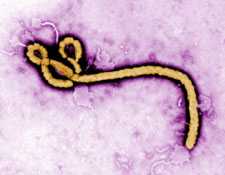EBOLA
NOTE: This page is archived for historical purposes and is no longer being maintained or updated.
The recommendations on this page are no longer in effect and will not be updated.
Healthcare Workers
 CDC has developed guidance for:
CDC has developed guidance for:
- Healthcare workers
- Deployed Ebola responders
- Laboratory workers
- Emergency medical service workers
- Air medical transport workers
- Funeral and mortuary workers
Standard, contact, and droplet precautions , including the use of appropriate personal protective equipment (PPE) , are recommended for management of hospitalized patients with known or suspected Ebola. Healthcare workers are advised to be alert for signs and symptoms of Ebola in symptomatic patients who have travelled within 21 days to countries where the outbreak is occurring.
Laboratory workers and other healthcare personnel who collect or handle infectious specimens should follow established procedures that match the OSHA bloodborne pathogens standard , which includes guidance on handling blood and other potentially infectious materials.
For current information for healthcare workers, visit the CDC Ebola Healthcare Workers webpage .
Personal Protective Equipment (PPE) for Healthcare Workers
Ebola Personal Protective Equipment Frequently Asked Questions
OSHA Fact Sheet: PPE Selection Matrix for Occupational Exposure to Ebola Virus
Respiratory Protection Resources
Video: Respiratory Protection for Ebola
Personal Protective Equipment Training: Donning and Doffing Procedures
Medscape Ebola video: Donning and Doffing of Personal Protective Equipment
Healthcare Workers
CDC Guidance
Ambulatory Care Evaluation of Patients
Emergency Department Evaluation and Management of Patients
Screening and Caring for Pregnant Women
Infection Prevention and Control
Specimen Collection, Transport, Testing, and Submission
Environmental Infection Control
Safely Performing Acute Hemodialysis
Safe Handling of Human Remains
Survivability of the Ebola Virus in Medical Waste
Monitoring and Movement Guidance
Additional Resources
When Caring for Suspect or Confirmed Patients with Ebola
Checklist for Healthcare Coalitions for Ebola Preparedness
Cal/OSHA Interim Guidance on Ebola Virus in Inpatient Hospital Settings
Deployed Ebola Responders
NIOSH-OSHA Fact Sheet: Preventing Worker Fatigue Among Ebola Healthcare Workers and Responders
Interim NIOSH Training for Emergency Responders: Reducing Risks Associated with Long Work Hours
NIOSH Factsheet: The Buddy System
- Training Slides: Limiting Heat Burden While Wearing PPE
- Poster: Prevent Heat Related Illness - Wearing PPE Increases Your Risk for Heat-related Illnesses
CDC Non-U.S. Healthcare Settings
Laboratory Workers
Emergency Medical Service Workers
Algorithm for Emergency Medical Services and 9-1-1 Public Safety Answering Points
Detailed Emergency Medical Services (EMS) Checklist for Ebola Preparedness
Ebola Virus Disease Screening Criteria for EMS
Air Medical Transport Workers
Guidance on Air Medical Transport for Patients with Ebola Virus Disease
Funeral and Mortuary Workers
Guidance for Safe Handling of Human Remains of Ebola Patients in U. S. Hospitals and Mortuaries
- Page last reviewed: October 31, 2014 (archived document)
- Content source:
- National Institute for Occupational Safety and Health Office of the Director


 ShareCompartir
ShareCompartir